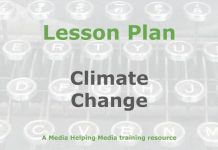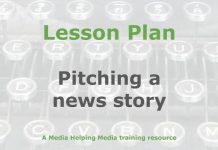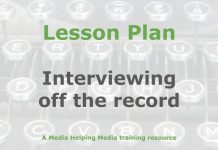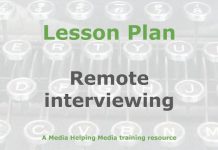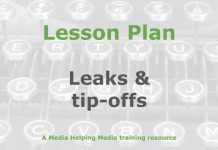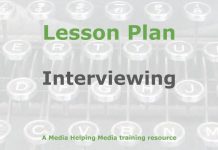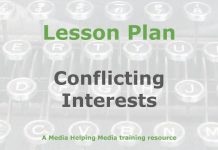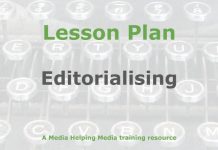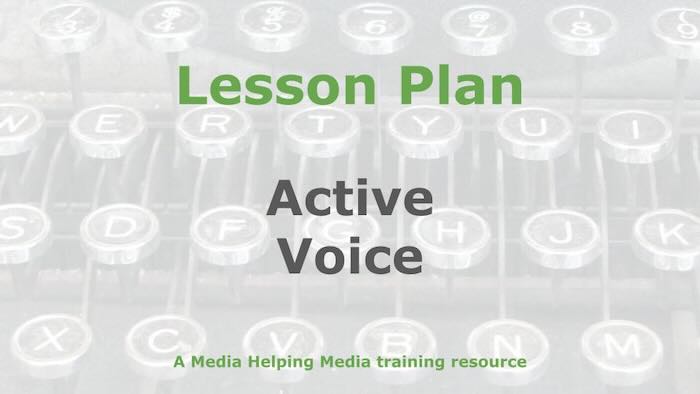 This lesson plan is designed to help journalism students understand the difference between using the active voice and the passive voice in their news writing.
This lesson plan is designed to help journalism students understand the difference between using the active voice and the passive voice in their news writing.
It’s based on the article ‘The active and passive voices in news‘ which is published on Media Helping Media. We suggest you read the article before adapting this lesson outline for your own purposes.
Learning objective
Students will identify and differentiate between the active and passive voices in news writing. They will apply this understanding to rewrite sentences, enhancing clarity and impact.
- Student-facing objective: By the end of this lesson, the student will be able to spot active and passive voices in news articles and rewrite sentences to make them clearer and more engaging.
- Standards: any news stories are about action. That should be captured to seize the attention of the audience. One of the ways is by choosing the active voice.
Learning activities
Warm-up
Display two sentences on the board:
- “The cake was eaten by the children.”
- “The children ate the cake.”
Ask students to decide which sentence is more direct and engaging. Have them signal their choice. Invite a few students to share their reasoning. Highlight the use of active and passive voices in each sentence. This primes students for the lesson’s focus on identifying and using the active voice in news writing.
Direct instruction
- Introduction to the use of the active and passive voices: Begin by explaining the difference between active and passive voices using simple examples. Use the sentences from the warm-up: “The cake was eaten by the children” (passive) and “The children ate the cake” (active). Emphasise that the active voice is more direct and engaging, which is a powerful factor in news writing. Discuss how the active voice places the subject at the forefront, making the action clear and immediate.
- Examples: Present two news headlines, one in the active voice and one in the passive voice. For example, “Firefighters rescue family from burning building” (active) versus “Family rescued from burning building by firefighters” (passive). Ask students to identify which headline is more compelling and why. Highlight how the active voice in news stories captures attention and conveys urgency.
- Analysing impact and meaning: Discuss how the choice between the active and passive voices can affect the meaning and impact of a sentence. Use the example of political language: “Mistakes were made” (passive) versus “I made mistakes” (active). Explain how the passive voice can obscure responsibility, while the active voice clarifies it. Encourage students to consider the implications of voice choice in news writing and its potential to influence public perception.
Guided practice
Think, Pair, Share
- Think: Present students with a news excerpt written in the passive voice. Ask them to individually rewrite it in the active voice, focusing on clarity and engagement.
- Pair: Have students pair up to compare their rewritten sentences. Encourage them to discuss the changes they made and the reasons behind their choices.
- Share: Invite pairs to share their sentences with the class. Facilitate a discussion on the effectiveness of the active voice in each example.
- Feedback: Provide feedback on the use of active voice, highlighting strong verbs and sentence structure.
- Reflection: Ask students to reflect on how the active voice changes the impact of the news excerpt and why it might be preferred in journalism.
Independent practice
- Provide students with a worksheet containing several sentences from news articles written in the passive voice.
- Instruct students to rewrite each sentence in the active voice, focusing on clarity and engagement.
- Encourage students to use strong verbs and ensure the subject is performing the action.
Circulate the classroom to offer guidance and support as needed.
Assignment
Ask students to answer these questions:
- How does using the active voice change the impact of a news story?
- Why might a journalist choose to use the passive voice in certain situations?
- What’s one question you still have from today’s lesson?
Here are some suggested answers:
- Suggested answer to Question 1: The active voice makes a news story more direct and engaging, placing emphasis on the subject performing the action.
- Suggested answer to Question 2: A journalist might use the passive voice to emphasise the object of the action or to obscure responsibility.
Teacher resources
Differentiation guide
- Advanced learners: Encourage them to explore the nuances of voice choice in complex news articles. Assign tasks that involve analysing the impact of voice on reader perception and the subtleties of political language. Challenge them to rewrite entire news articles, maintaining the original meaning while shifting between active and passive voices.
- Striving learners: Provide additional examples and practice with simpler sentences. Use visual aids to illustrate the differences between the active and passive voices. Offer sentence starters to guide their rewriting process. Pair them with peers for collaborative learning and support.
- Background reading: This lesson plan is based on the article ‘The active and passive voices in news‘ which is published on Media Helping Media. We suggest you read the article before adapting this lesson outline for your own purposes.
Notable definitions
- Active voice: A sentence structure where the subject performs the action expressed by the verb. Example: “The journalist wrote the article.”
- Passive voice: A sentence structure where the subject receives the action expressed by the verb. Example: “The article was written by the journalist.”
- Subject: The person, place, thing, or idea that is doing or being something in a sentence. In the active voice, the subject performs the action; in the passive voice, the subject receives the action.
Required materials
- Whiteboard and markers
- Projector and screen
- Printed worksheets with passive voice sentences
- Copies of news articles for analysis
- Pens and paper for student notes
Lesson summary
- Warm-up
- Direct instruction
- Guided practice
- Independent practice
- Assignment
The free teaching tools at the Khan Academy were used as a basis for converting the original article into a lesson plan.
Related articles
